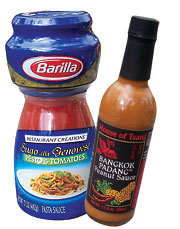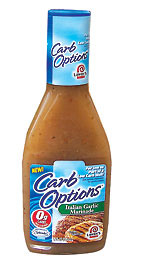Dressing Down

The onset of the low-carb revolution brought with it an increase in the consumption of beef, poultry and other meats. Likewise, considering the widespread usage of cooking sauces and marinades as flavor enhancers for these protein sources, recent years should have been perfect for sauce makers. Sales statistics, while not outrageously strong, were largely positive, yet development in low-carb took time for some manufacturers. A search of Mintel International's Global New Products Database (GNPD) finds only three low-carb cooking sauces introduced in 2003, the same number as in 2002. The pace increased in 2004, which saw 16 such introductions, and went into overdrive through November of 2005, with 30 new offerings. Unfortunately, these efforts may be too late.
Research by Opinion Dynamics Corporation (ODC) shows the low-carb craze hit its peak in early 2004 and, while the diet trend has not disappeared, it is not growing either. ODC's latest survey, performed in August of 2005, finds 13% of the public saying they are on some form of a low-carb diet, an amount which has remained fairly consistent since the height of the trend in 2004.
Interestingly, the behavior of those dieters shows many more subtle changes to their eating patterns than in 2004, meaning the impact of low-carb diets upon the food and beverage industry will be much smaller. Furthermore, “Research conducted by ODC in 2004 showed that low-carb dieters were not looking for specialty products to serve as alternatives to high-carb foods. In other words, there never was strong interest in low-carb diet products, even at the height of the craze. There is less interest in low-carb products today than there was a year ago.”

On the Sauce
So, with one door shut, another seems to open, albeit from a possibly unexpected source. H.J. Heinz Co., in maneuvering to gain an FDA health claim for lycopene on its ketchup, may have opened a marketing path for manufacturers of tomato-based sauces.The regulators cleared the way for food companies to cite certain of tomatoes' cancer-fighting benefits in ads and on food labels, although any claims for fresh, dried or canned tomatoes must be qualified, because they are not proven completely. In fact, companies are required to specify the limits of the scientific evidence.
For the prostate cancer claim, the agency suggests manufacturers tell consumers: “Very limited and preliminary scientific research suggests that eating one-half to one cup of tomatoes and/or tomato sauce a week may reduce the risk of prostate cancer. FDA concludes that there is little scientific evidence supporting this claim.”
In addition, companies can say eating tomatoes and tomato sauce is linked with a reduced risk of gastric, ovarian and pancreatic cancers. That allowance is wider than the prostate cancer claim a coalition led by H.J. Heinz Co. had sought.
As Heinz spokesperson Debbie Foster noted, the decision appears to allow many of the company's Classico brand pasta sauces to qualify for the prostate cancer claim. “It is important to note that our petition was not for ketchup, but rather tomato products.”
“We're delighted with the FDA's announcement, reinforcing what Heinz has long believed about the health benefits of tomatoes,” said F. Kerr Dow, PhD, vice president and chief technical officer for Heinz. “It validates Heinz's long-term support of tomato research and our ongoing education program. As the FDA confirmed, research findings are still limited, and scientific studies must continue on tomatoes and their link to preventing disease and enhancing well-being.”
Dow noted, “Based on health claim guidance provided by the FDA, the risk of prostate cancer may be reduced by eating 1/2 to 1 cup of tomatoes and/or tomato sauce--such as a single serving of Classico pasta sauce--per week.”
How large of an impact could the FDA's decision have? A search of the GNPD for cooking and pasta sauces introduced in the U.S. this year with tomatoes in the ingredient legend found 156. Last year had 132 such introductions, with another 131 in 2003. Add another 286 salsa introductions with tomatoes since 2003, and the FDA may have created a sizable health food category in one fell swoop. In the case of pasta sauces and salsas, it also would be one that meets another important trend: increased flavor.
No Compromise
At the same time, that increase in flavor can be presented in a healthful manner, echoing Napa Valley chef and author Michael Chiarello's goal of “convenience without compromise,” manifested when creating the Consorzio line of products. “People were growing tired of food prepared by chemists and were interested in more wholesome, healthful eating. But because they had less and less time for cooking, they needed solutions that would give them big flavor without a lot of effort.” The Consorzio line has grown to encompass dressings, oils, barbecue sauces and marinades.If any one segment could use help in consumer eyes, it would seem to be marinades. Some 216 new products this year cited “marinade” in their product description, with 176 hitting the shelves last year. Nevertheless, a number of manufacturers report the products are not selling particularly well, prompting a repositioning of the items as barbecue or grilling sauces. For the record, according to the GNPD, of the total number of products introduced this year with the term “marinade” in their product description, 120 actually were called “marinades,” with another 100 in 2004. Nonetheless, many manufacturers regard the term “marinade” as a difficult sell and prefer to speak to the consumer with terms like “barbecue” or “grilling.”
Complicating matters for marinades could well be consumer perception of them as ineffective. Andrew Bosch, senior creative flavorist with an ingredients supplier, notes most chicken breast products found in supermarkets already have been injected or tumbled with chicken broth. While this may result in a moister and easier-to-cook meat, “The consumer does not realize it. They take it home and try to use a marinade, but the chicken cannot absorb it. It is already saturated and will not absorb the flavors.”
At first, this may seem like a pitfall for marinade manufacturers, but Bosch actually sees potential for them and for retailers. After all, if the meat pack can indicate it has been pre-marinaded, the consumer will know in advance if the cooked product actually will taste like the promise of the store-bought marinade. Furthermore, if the product has not been pre-marinaded, the producer can make on-package suggestions for marinade flavors, benefiting the consumer, the producer, the manufacturer and, in the long run, even the retailer.
The Food Industry Research Center reports marinades are gaining popularity with consumers, largely due to the trend toward quicker, more flavorful cooking. Leading the way are popular Asian flavors (teriyaki, honey teriyaki and sesame ginger), in addition to herb and garlic and mesquite. Yet, as demonstrated by the GNPD search for products specifically termed “marinade,” salad dressings, flavored olive oils, and organic specialty oils and vinegars frequently double as marinades.
In creating salad dressings and marinades for topping cool, crisp salads or flavoring meat, poultry or fish, Wish-Bone (Bestfoods) decided to create a dual-purpose concept in four flavors: Lemon Garlic & Herb, Asian Sesame, Balsamic Olive Oil & Herbs and Tangy Honey Mustard. Avoiding pesky issues of nomenclature and potential confusion to the consumer, the products are known simply as Wish-Bone Dressing & Marinade.
The only potential problem would be the addition of the term “marinade” to the label, since consumers embrace dressings, according to Julie Currie of ACNielsen. Her research shows salad dressing is a staple in U.S. households, with an 89% penetration. Furthermore, 2003 data show consumers increased their expenditures on major dressings and sauces: salad dressings were up 3.1% from 2002, with mayonnaise increasing 2.6% in that time. The nearly $9 billion dressing and sauce category had grown 2.6% over the previous three years.
In terms of ingredients, a GNPD search finds cheese as a popular ingredient in this year's dressing introductions, listed on the legend of 40 new products this year. However, cheese may seem a little run-of-the-mill for consumers quickly acclimating to intense flavor. Sue Denes, marketing specialist with Renee's Gourmet (Intercorp Excelle Foods Inc.), notes, “Consumers are looking for foods that deliver positive nutrition without sacrificing taste. Customer palates are becoming more sophisticated, and innovation is the key: studies show unconventional items in conventional categories are what consumers are after.”

Grand Experiment
Bob Goldin, executive vice president of Technomic Inc., agrees, noting a distinct move toward experimentation. “Dressings are lighter, more ethnic-oriented and more oil-based, rather than creamy-based. Vinaigrettes of all types are where the growth is.”In fact, unconventional flavors are adding an upscale, gourmet positioning to recent dressing introductions. In foodservice, for instance, champagne has been incorporated into vinaigrettes in a number of family and fine dining establishments, reported Cara Newkirk, manager of consumer insight and innovation with a flavor manufacturer, at this year's Prepared Foods' R&D Conference. Mintel's Menu Insights finds champagne vinaigrette featured with flat iron steak salad in family dining, as well as in several fine dining applications, including raspberry champagne vinaigrette with summer salad, champagne vinaigrette with mixed greens and gorgonzola salad, and lobster salad with champagne vinaigrette.
A champagne-poached pear salad also has been seen in the fine dining category, and pear is another flavor seeing wider usage. A pear vinaigrette is featured with endive salad in fine dining, and the casual segment has roasted pear vinaigrette with spinach salad. While the two have only begun to make noticeable inroads into retail products (champagne was listed on eight retail dressings and oils introduced this year, with pear on nine), they do serve as an indication of where novel foodservice products are heading. Also making their way onto fine-dining menus and into some retail products have been sauces boasting such flavorful additions as blood orange, fig, pomegranate and tamarind, the latter of which also is found on casual and family restaurant menus.
An attempt to emulate foodservice-quality sauces netted Barilla America Prepared Foods' first Spirit of Innovation Award. The Restaurant Creations line of sauces not only endeavored to bring restaurant quality into the home, but was among the first such products to attempt to emulate authentic regional cuisine, in this case, reflecting influences of the Lazio, Campania and Liguria regions of Italy.
While the authentic movement may be relatively small (the term “authentic” appears in descriptions of 83 new sauces and seasonings over the past two years), American palates are seeking more flavorful foods. After all, this is an environment where Italian, Chinese and Mexican foods are considered mainstream, and flavor seekers are turning to such sauces as Thai barbecue, mango salsa and roasted chipotle.
Manufacturers are responding, either through flavorful additions to existing lines or with brands completely centered on ethnic cuisines. The latter option has proven a route of choice for Hormel, whose House of Tsang brand features boldly labeled products influenced by cuisines such as Thai, incorporating peanut, ginger and citrus elements. The House of Tsang products feature self-contained recipes for “consumers who desire convenient, authentically Asian dishes.” The line includes grill sauces (with such flavors as Spicy Hunan Smokehut and Thai Peanut), seasoned oils (including Mongolian Fire Oil and Hot Chili Sesame Oil), soy sauces and marinades, stir fry sauces (Bangkok Padang Peanut Sauce, Saigon Sizzle and Imperial Citrus among them) and traditional sauces (Hoisin Sauce and Spicy Brown Bean Sauce).
A combination of trends (low-carb and the desire for greater flavor variety) seemed tailor-made for robust sales of dressings, sauces and marinades. For whatever reason, that scenario failed to materialize, but the category still holds opportunity. As consumers re-embrace the once-dreaded carbohydrate, analysts predict they likewise will seek products healthful as well as flavorful. This segment is positioned to help them meet both of those goals, while adding another, most-important element--convenience.
Links
Looking for a reprint of this article?
From high-res PDFs to custom plaques, order your copy today!



